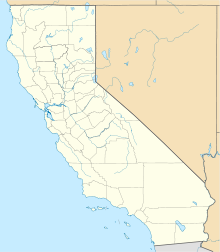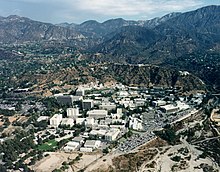Jet Propulsion Laboratory
Coordinates: 34 ° 11 ′ 58 " N , 118 ° 10 ′ 28" W.
The Jet Propulsion Laboratory (JPL; English for jet propulsion laboratory ) builds and controls satellites and space probes for NASA .
The JPL is part of the California Institute of Technology (Caltech) in La Cañada Flintridge ; under his leadership the most successful space probe projects of NASA were carried out. In order to be able to maintain contact with the probes, the JPL operates the Deep Space Network . In addition to NASA, the JPL also works for the United States Department of Defense , the Department of Energy and other government institutions. It also advises the producers of science fiction films and series (for example Babylon 5 ).
The JPL is now located on 72 acres in La Cañada Flintridge, California , but its official address is 4800 Oak Grove Drive, Pasadena, CA 91109. The JPL employs approximately 5,500 full-time employees and several thousand other service providers. In 2003, the budget was almost 1.4 billion US dollars .
history
JPL developed in the 1930s, when the Caltech - Professor Theodore von Kármán began with students and assistants, experiments with rocket engines perform. On October 31, 1936, they launched their first rocket.
Von Kármán convinced the US Army to support him. The army asked the newly formed team, the German V2 to investigate rocket, which for the first time the name Jet Propulsion Laboratory (Jet Propulsion for jet engine was used). The research facility was given this name in order to make a serious impression on the outside world, since at that time the work with rockets was considered dubious.
Based on the research results of the JPL, the Corporal missile was created , which the Americans put into service from 1955 and stationed in Europe. On December 3, 1958, NASA, which had been founded two months earlier, took over the JPL from the military. In contrast to the other centers, the JPL is not part of NASA, but only affiliated with NASA. JPL is part of Caltech University .
The JPL kept its name, although no research on jet propulsion (rockets) was carried out in the following period. Instead, it developed into the world's leading center for space probes, their technology, and planetary research. However, the JPL has recently faced serious competition from the Applied Physics Laboratory at Johns Hopkins University .
Space exploration
On January 31, 1958, JPL launched Explorer 1, the first satellite in the USA . In the 1960s the JPL started the first space probes to the moon ( Ranger ) and missions to other planets ( Mariner ). On December 14, 1962, Mariner 2 was the first spacecraft to fly past an alien planet ( Venus ). In 1976, the Viking probes were used for the first time to search for life on Mars . In 1977 Voyager 1 and Voyager 2 were launched to the outer planets. In October 1998, Deep Space 1, an ion-propelled space probe and other new technologies, was launched.
The cneos at JPL publishes the Sentry Risk Table , which regularly shows the current research results of the Sentry monitoring system on the impact risk of earth orbit cruisers .
Furthermore, the so-called JPL sequences were developed by JPL . These are special code sequences which are used, among other things, in space applications for distance measurement and which can shorten the synchronization times for spread spectrum signals . Furthermore, JPL sequences are used in the global positioning system (GPS) for transmitting the P / Y code used by the military.
Earth exploration
In the 1970s, the JPL showed that the instruments on board space probes could also be used to study the earth, which resulted in the Seasat mission.
Missions
JPL missions include:
- Explorer 1 to 5
- Mariner 1 through 10
- Ranger 1 to 9, Surveyor 1 to 7
- Seasat
- Viking 1 and 2
- Voyager 1 and Voyager 2
- Galileo
- Magellan
- The Mars rovers Pathfinder , Opportunity and Spirit
- Cassini
- Mars Science Laboratory
- Dawn
- InSight
- Mars 2020
JPL also built instruments for other projects, such as the wide-angle camera of the Hubble Space Telescope , and testing new technologies for NASA, such as the Low-Density Supersonic Decelerator .
List of directors
| Surname | from | to |
|---|---|---|
| Theodore von Kármán | 1938 | 1944 |
| Frank Malina | 1944 | 1946 |
| Louis Dunn | 1946 | 1954 |
| William Hayward Pickering | 1954 | March 31, 1976 |
| Bruce C. Murray | April 1, 1976 | June 30, 1982 |
| Lew Allen, Jr. | July 22, 1982 | December 31, 1990 |
| Edward C. Stone | January 1, 1991 | April 30, 2001 |
| Charles Elachi | May 1, 2001 | June 30, 2016 |
| Michael M. Watkins | since July 1, 2016 |
Web links
- Official website (English)
- JPL, et al. a. List of all missions (English, PDF, 137 KiB)
Individual evidence
- ↑ Nicholas Booth: The exploration of the solar system: Breathtaking images from space , BLV, Munich 1996, ISBN 3-405-15022-1 , p. 12
- ^ JPL Sentry Risk Table



